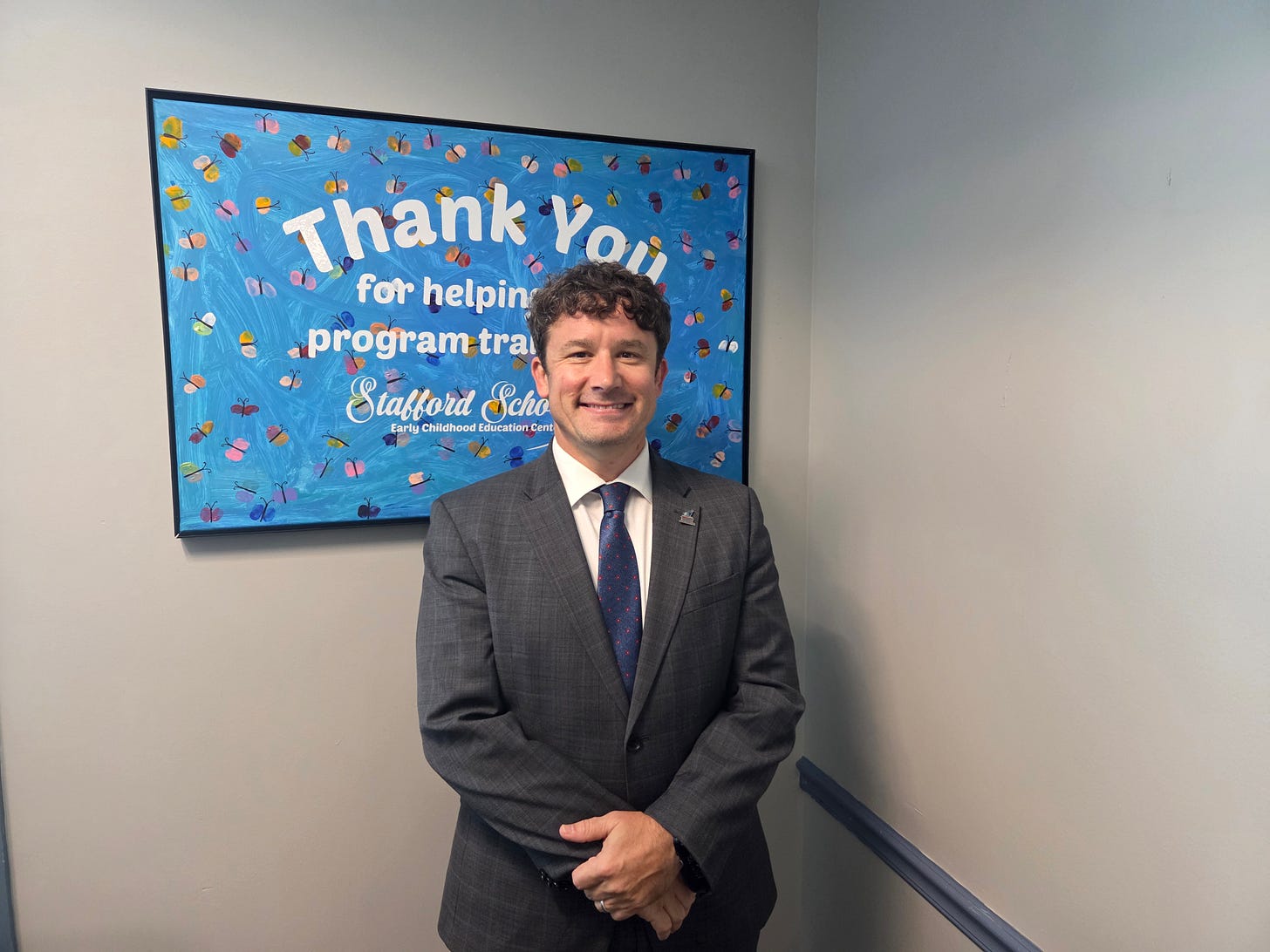Relationships, Families, Instruction
Stafford County Public Schools is undertaking new initiatives and preparing for three new schools to open next year. For Daniel Smith, however, the basics still drive quality education.
By Martin Davis
EDITOR-IN-CHIEF
Email Martin
Daniel Smith started his new job as Stafford Schools superintendent in December 2024. One would think starting any school job halfway through the year would be difficult, but Smith doesn’t see it that way.
“I think it worked out well,” he said in a meeting with local media on Monday at the Stafford County Public Schools offices. “Within a half a year … [you can say] alright, we need to shift this, we can do better here. You don’t have to wait a full year to change things and make things better.”
One of the improvements the division looks to make is in transportation. Last year, the division got off to a rough start matching students to buses. The combination of a new office structure and new staff in the transportation department, plus new bus routing software, led to between 3,000 and 3,500 students not having assigned bus routes when school started.
This year, however, the district looks ready to roll on Day 1. Improvements have come on two fronts.
Smith said that in examining what happened last year, they discovered existing delays in arrival and dismissal times. The problem was a bottleneck at the elementary level.
“We go to high schools first,” he said, “then you go to 17 elementary” schools and “it just bottlenecks.”
The solution is splitting the start times for elementary schools. Nine schools will start at 8:15, eight will begin at 8:45. (For a list of elementary schools by tier and their new start times, visit 2025-2026 Elementary Start Times.)
The pairing of schools by tiers was done intentionally. It “allowed us to pair our longer routes with our shorter routes” to have better on-time arrivals.
A second change is having people opt-in to bus transportation.
Typically, the county routed every child in the district and then would figure out which children weren’t getting on the bus. This meant lots of rerouting during the first couple weeks of school.
In the past, the district routed every child and then figured out who wasn’t getting on the bus. This year families were able to opt-in to bus service. “We have over 5,000 or 6,000” that chose not to opt-in, Smith said. The district won’t be routing those students. This should help improve efficiency beginning the first day of school.
Adjustments will have to be made as families’ plans change, of course, so rerouting will still be occurring. But things should run much smoother, Smith said.
Finally, the transportation team is fully staffed this year. Drivers will begin practicing their routes next week, and families already have access to bus routes. This is two weeks prior to the first day of school—the earliest that’s occurred.
It all should add up to a much smoother first day.
Technology Upgrades
Other changes this year include new Chromebook purchases, mainly for the middle schools. There are also policies around how those Chromebooks are handled.
First, “we have a parent acknowledgment” prior to issuing the Chromebook, Smith said, “so that there are charges if you destroy the device or it gets broken.”
Along with this, however, the district is also offing insurance to parents. “So, for $26.95, they can buy insurance for their device and a charger,” Smith said. The insurance is good for the entire year. A lost charger costs $40 to replace, so the insurance is a way to hedge against those potential costs.
Another change is that the division will be providing training for middle and high school students on how to care for and handle the Chromebooks.
“We are working with our teachers to deploy that in the first weeks, so kids won’t get a device immediately when they come in,” Smith said. This allows time to train the kids in device care and secure the parent acknowledgments.
Artificial Intelligence is another area in which some changes are coming.
The district has an AI policy, but Smith said that “all our teachers are going through AI training this year.”
The focus is on helping educators understand what AI is and how to use it in the proper way.
Smith uses a bicycle analogy to help explain the proper use of AI.
“AI is like an electric bike,” he said. “You still have to balance, steer, navigate the terrain, but it allows you to be more efficient, allows you to go faster for longer periods of time.”
One area where the district is looking to leverage AI is in looking for ways to ease teachers’ workloads.
While the details aren’t in place, this year the district will be putting together a group of teachers to take a close look at everything they are being asked to do, and in what places the district might be able to reduce the workload.
“That’s the goal,” Smith said. “It’s not just focused on AI, it’s about workload in general.”
High-Quality Instruction
Smith said that the county has a framework for student learning, “but we had not really implemented it yet.”
That framework identifies what good instruction looks like in the classroom, and discussing these with staff and teachers as they return is going to be a significant push this year.
What are these components?
First, it’s about “being clear with kids around what they should be learning, and why.” The “why” isn’t just to do well on an SOL test; rather, the why is how it’s meaningful, and being explicit about the learning keys for the day.
The second piece deals with assessments, and Smith stresses being sure every kid is understanding what is happening. How do we do that? Getting that right allows teachers to know who’s getting it and who isn’t, and to plan for what to do for those who aren’t getting it.
The final piece is engagement. “How do I engage [students] in a real, meaningful way, so that they are actively thinking.”
This means making sure that every kid has an opportunity to demonstrate that they are getting the material.
Finances
One source of anxiety for all districts this year has been the federal government’s holding back funds.
Smith was concerned about funds for Title IIA, Title IIIA, and Title IVA. In total, the county was expecting about $1.19 million from these funding streams.
He recently learned, however, that the funds are being released and are now available.
Title I and IDEA funding are also locked in.
Regarding state funding, Smith says he’s not aware of any concerns.
At the county level, Smith said that he “was pleased where we ended up.”
He said the county’s two boards worked together on how to be “one Stafford…. The county opted to do the meals tax” to get school raises up. Smith said “that was a great effort on their part.”
He also said the district saw improvements in funding both for its capital improvement plan and for “3R”—repair, replace, or rehabilitation—projects.
Partnership with George Mason University
Also new this year is a memorandum of understanding with George Mason University for direct admission of qualifying students.
Following up on the meeting on Monday, Chief Communications Officer Sandra Osborn sent the guidelines for Stafford students to be eligible for automatic admission to what is now Virginia’s largest university by enrollment.
“George Mason shall determine eligibility of a Stafford Schools student to qualify for an offer of direct admission based on information provided by Stafford Schools. Generally, the following minimum criteria shall apply:
“1. A student must have earned a 3.25 cumulative weighted GPA in courses completed by the end of their junior year.
“2. A student must be in good standing with Stafford Schools as of the date on which the student commences their senior year.
“3. All University academic policies, as articulated in George Mason's catalog and policy guides, apply to students admitted via direct admission.”
The university has similar arrangements with Prince William, Fairfax, and other Northern Virginia divisions.
It All Comes Back to the Basics
As the discussion wound down, the Advance asked Smith what he felt the two or three most-important initiatives would be for the upcoming year.
“There’s a lot of initiatives … [and] we want to continue to improve,” he said, referencing technology and transportation.
“But,” he continued, “for me, and my message to our teachers is, build relationships with your kids, know who your kids are, take the time to get to know who they are, what they like, what they dislike.”
And there’s a second message to teachers: “communicate and partner with our families. We want to work alongside of our families … so we welcome them in.”
He then said, “That sounds like just back-to-the-basics, but that’s really what it’s about.”
And finally — “it’s also about high quality instruction.” Knowing what good instruction looks like.
“But honestly,” he concluded, “it comes down to, it’s about relationships; it’s about communication; it’s about high-quality instruction.
Updated on August 7 at 7:04 a.m. to reflect that students opt-in to bus transportation.
Local Obituaries
To view local obituaries or to send a note to family and loved ones, please visit the link that follows.
Support Award-winning, Locally Focused Journalism
The FXBG Advance cuts through the talking points to deliver both incisive and informative news about the issues, people, and organizations that daily affect your life. And we do it in a multi-partisan format that has no equal in this region. Over the past year, our reporting was:
First to break the story of Stafford Board of Supervisors dismissing a citizen library board member for “misconduct,” without informing the citizen or explaining what the person allegedly did wrong.
First to explain falling water levels in the Rappahannock Canal.
First to detail controversial traffic numbers submitted by Stafford staff on the Buc-ee’s project
Our media group also offers the most-extensive election coverage in the region and regular columnists like:
And our newsroom is led by the most-experienced and most-awarded journalists in the region — Adele Uphaus (Managing Editor and multiple VPA award-winner) and Martin Davis (Editor-in-Chief, 2022 Opinion Writer of the Year in Virginia and more than 25 years reporting from around the country and the world).
For just $8 a month, you can help support top-flight journalism that puts people over policies.
Your contributions 100% support our journalists.
Help us as we continue to grow!
This article is published under Creative Commons license CC BY-NC-ND. It can be distributed for noncommercial purposes and must include the following: “Published with permission by FXBG Advance.”















